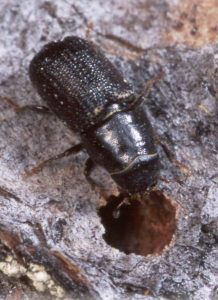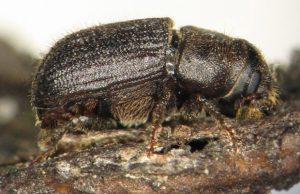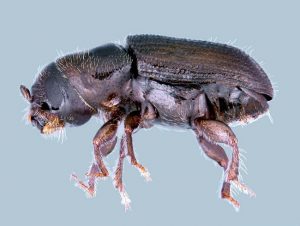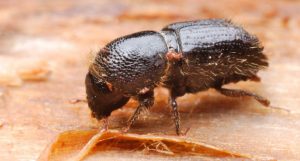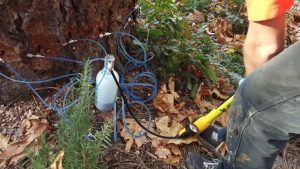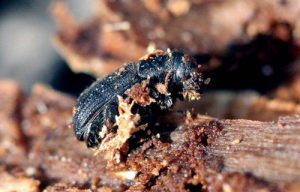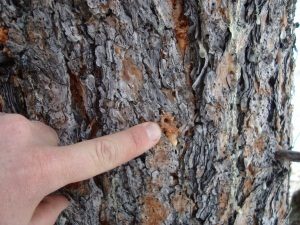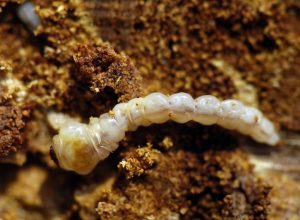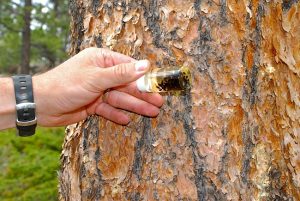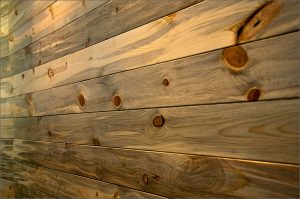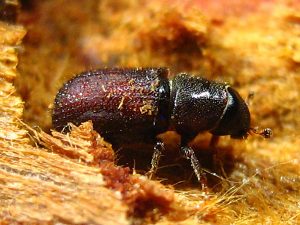Pine Beetle
The pine beetle is a member of the subfamily of bark beetles infesting the trees in North American forests. The aggressive tree-killing insects live primarily in pine trees of all vigor quality and ages. Group killing may occur in dense, pure, and even-aged pine stands or among clusters of pine in mixed-conifer stands. An epidemic may cause depletion of timber supplies and increase the danger of forest fire.
Scientific Classification
| Kingdom | Animalia |
| Phylum | Arthropoda |
| Class | Insecta |
| Order | Coleoptera |
| Family | Curculionidae |
| Subfamily | Scolytinae |
Pine Beetle Species
Some common species of pine beetles include
- Mountain pine beetle or Dendroctonus ponderosae: These pine beetles typically live in whitebark, ponderosa, Scotch, jack, limber, and lodgepole pine trees. Normally, they attack old or fragile trees and thus speed up the development of younger forests.
- Southern pine beetle or Dendroctonus frontalis: They commonly inhabit loblolly, Virginia, shortleaf, and pond pines, with attacks generally restricted to damaged, stressed, or old trees. During an outbreak, they can also invade healthy trees.
- Western pine beetle or Dendroctonus brevicomis: These insects invade and kill Coulter and ponderosa pine trees.
- Mexican pine beetle or Dendroctonus mexicanus: Montezuma, Chihuahua, Egg-cone, and Smooth-bark Mexican pine are their primary hosts.
Quick Information
| Other Names | Pine bark beetle, Pine borer beetle, Rocky Mountain pine beetle, Black Hills pine beetle |
| Identification | Size: Approximately 0.2 inch (5 mm) Color: Black, dark brown |
| Distribution/Range | Mountain pine beetle: from Mexico-central British Columbia Southern pine beetle: southern and southeastern US; Pennsylvania, New Jersey, Arizona, New Mexico; also occurs in Mexico, central America, and northern Nicaragua Western pine beetle: California, Washington, Idaho, Oregon, British Columbia, Nevada, Montana, Colorado, New Mexico, Arizona, Utah, and western Texas Mexican pine beetle: from Chihuahua to Oaxaca and Chiapas |
| Lifespan | About 1 year |
| Predators | Birds such as woodpeckers; other insects |
| Stages of Life Cycle | Eggs: shiny, opaque, oval-shaped, approximately 1.5X1.0 mm in size Larvae: legless, wrinkled, 2-7 mm long, yellowish-white Pupae: yellowish-white with red-colored heads Adults: hard exoskeleton, broad, prominent head, rounded abdomen, cylindrical body, short legs |
| Time to Maturity | 26-60 days |
| Pine Beetle Wood Uses | Commercial value of the timber from beetle-affected trees declines rapidly; the wood can still be utilized for producing cross-laminated panels and glue-laminated products, making crafts and furniture from the blue-stained wood; also used in biofuel or alternative energy production |
Infestation
Female beetles start the invasion by selecting the host. They bore into the tree bark, releasing pheromones, which attract more females and males to the tree. As more pheromones are produced by the attacking beetles, a mass attack occurs overcoming the resin production system, which is the defense mechanism of the tree. Long S-shaped galleries are constructed soon after mating and about 30 eggs are laid in cavities along each gallery.
Life Cycle
Eggs hatch 3-9 days after they are laid. The larvae cut through the inner phloem, constructing looping galleries perpendicular to the egg galleries. During their developmental stage, they gradually move towards the outer bark, forming a pupal cell. After remaining in the pupal stage for 5-17 days, they become callow adults. The young adults stay under the bark until their cuticle becomes dark and hard. Then they fly off to invade another tree by boring a tunnel through the outer bark.
Control and Treatment
Small-scale infestations can be managed by using the following techniques
- Sanitation harvesting: Single infested pine trees can be removed to prevent the beetles from spreading to other areas.
- Fall and burn: The infested trees are cut and burned to reduce their spreading population.
- Pheromone baiting: Beetles are lured into a single area using a synthetic hormone, which has the same smell of female beetles. This helps in destroying the beetles more easily.
- Pesticides: Spraying trees with pesticides including bifenthrin, permethrin, and carbaryl is useful in preventing pine beetle attacks on high-value trees. Biopesticides like chitosan can be used to protect trees from beetle infestations.
Interesting Facts
- Extreme winter conditions affect beetle populations and can slow down their spread.
- The current beetle epidemic in the RMNP, Colorado started in 1996, and since then it has destroyed millions of acres of pine trees.
- Popcorn-shaped lumps of resin, known as “pitch tubes,” are visible in the outer bark of trees that are infested with beetles.
- When invaded by beetles, a tree remains green initially, but its needles gradually turn red.
References
- https://en.wikipedia.org/wiki/Mountain_pine_beetle
- https://www.nps.gov/romo/learn/nature/mtn_pine_beetle_background.htm
- https://natural-resources.canada.ca/forests/fire-insects-disturbances/top-insects/13397
- https://csfs.colostate.edu/forest-management/common-forest-insects-diseases/mountain-pine-beetle/
- https://csfs.colostate.edu/forest-management/common-forest-insects-diseases/mountain-pine-beetle/
Published on October 31st 2016 by admin under Coniferous Forest Animals.
Article was last reviewed on 9th May 2023.


